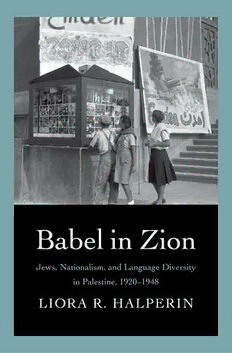
Babel in Zion: Jews, Nationalism, and Language Diversity in Palestine, 1920-1948 PDF
Preview Babel in Zion: Jews, Nationalism, and Language Diversity in Palestine, 1920-1948
BABEL IN ZION This page intentionally left blank B A B E L I N Z I O N JEWS, NATIONALISM, AND LANGUAGE DIVERSITY 1920 1948 IN PALESTINE, – Liora R. Halperin New Haven & London Published with assistance from the Louis Stern Memorial Fund. Copyright © 2015 by Yale University. All rights reserved. This book may not be reproduced, in whole or in part, including illustrations, in any form (beyond that copying permitted by Sections 107 and 108 of the U.S. Copyright Law and except by reviewers for the public press), without written permission from the publishers. Yale University Press books may be purchased in quantity for educational, business, or promotional use. For information, please e-mail [email protected] (U.S. offi ce) or [email protected] (U.K. offi ce). Set in Baskerville type by IDS Infotech Ltd., Chandigarh, India. Printed in the United States of America. Library of Congress Cataloging-in-Publication Data Halperin, Liora. Babel in Zion : Jews, nationalism, and language diversity in Palestine, 1920–1948 / Liora R. Halperin. pages cm Includes bibliographical references and index. ISBN 978-0-300-19748-8 (hardcover : alk. paper) 1. Multilingualism—Palestine—History—20th century. 2. Jews— Palestine—Languages—History—20th century. 3. Hebrew language— Palestine—History—20th century. 4. Jews—Identity. I. Title. P115.5.I75H35 2014 404’.20956940904—dc23 2014016767 A catalogue record for this book is available from the British Library. This paper meets the requirements of ANSI/NISO Z39.48–1992 (Permanence of Paper). 10 9 8 7 6 5 4 3 2 1 To Sasha, my partner on this journey This page intentionally left blank CONTENTS Note on Transliteration and Translation, ix Acknowledgments, xi INTRODUCTION Babel in Zion, 1 CHAPTER ONE Languages of Leisure in the Home, the Coffeehouse, and the Cinema, 26 CHAPTER TWO Peddlers, Traders, and the Languages of Commerce, 62 CHAPTER THREE Clerks, Translators, and the Languages of Bureaucracy, 99 CONTENTS CHAPTER FOUR Zion in Babel: The Yishuv in Its Arabic-Speaking Context, 142 CHAPTER FIVE Hebrew Education between East and West: Foreign-Language Instruction in Zionist Schools, 181 CONCLUSION The Persistence of Babel, 222 Notes, 231 Bibliography, 275 Index, 303 viii NOTE ON TRANSLITERATION AND TRANSLATION Throughout this book I have followed the Library of Congress transliter- ation system for Hebrew, with a few modifi cations. I use “tz” rather than “ts” for tzadi, and I omit most diacritical marks and dots. On occasion, an additional apostrophe is used to remove ambiguity (e.g., mis’har rather than mishar). In cases where a person’s name is conventionally spelled dif- ferently from how my transliteration would suggest, I retain the conven- tional spelling. I use English terms for Zionist institutions such as the Jewish Agency (Ha- sokhnut ha- Yehudit), the Jewish National Council (Ha-Va‘ad Ha-L e’umi), and the Central Council for the Enforcement of Hebrew (Ha- mo‘atzah ha- merkazit le- hashlatat ha- ‘Ivrit). In a few cases, institutions that have well- known Hebrew names, such as the Histadrut, are referred to by that name. When transliterating words that came to Hebrew from English, I often maintain spellings closer to English even when the standard transliteration system would indicate otherwise (e.g., Briti rather than Beriti). During the British mandate period, Jews, Arabs, and foreigners all used the term “Palestine” when they were writing in English about the politi- cal unit they were living in. When Jews prepared Hebrew and English iixx
